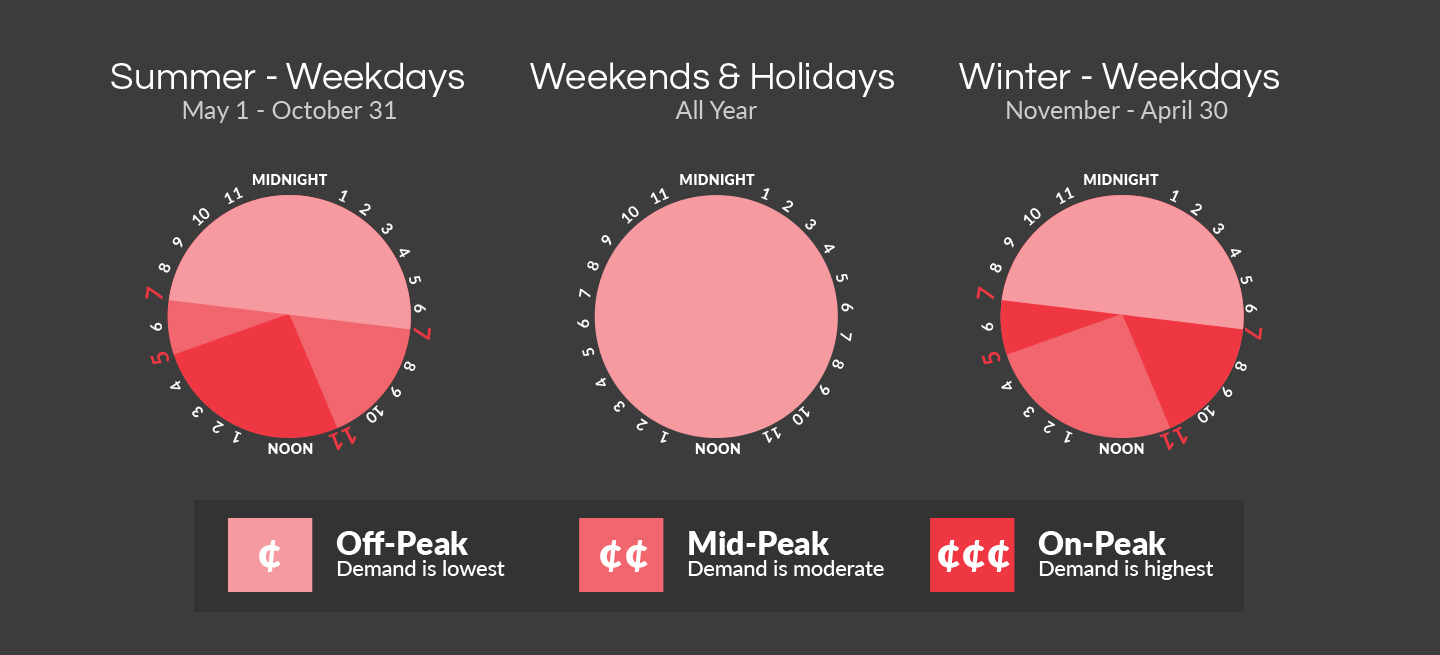Time-of-use (TOU) Prices
The majority of Ontario electricity users pay time-of-use prices. If you’ve signed an electricity contract with a company, these prices will not affect you. There are three time-of-use price periods:
-
Off-peak, when demand for electricity is lowest. Ontario households use the majority of their electricity – nearly two thirds of it – during off-peak hours.
-
Mid-peak, when demand for electricity is moderate. These periods are during the daytime, but not the busiest times of day.
-
On-peak, when demand is highest. The busiest times of day. Generally when people are cooking, firing up their computers and running heaters or air conditioners.
The chart above below shows the price you pay today for electricity at different times of the day.
Reasons for Higher and Lower Prices
Time-of-use electricity prices are cheapest when demand is lowest: during the evenings, on weekends and on holidays.
When demand is lower, most of the power we use comes from sources like nuclear generators and large hydroelectric stations, which are designed to run all the time. This is called “baseload” power.
As daytime begins, more people turn on their lights and appliances, and businesses ramp up their operations for the workday. These are high demand times, and if all of the baseload power is used, the province turns to generally higher-cost sources. These sources, such as natural gas-fired plants, can be quickly called into action to meet rising demand.
Two PEAK Seasons: Summer & Winter
People use electricity differently depending on the season. The Ontario Energy Board, therefore, has established two sets of peak prices. These prices only apply to weekdays. Electricity is at its cheapest price all day on weekends and holidays throughout the year.
| Summer Weekdays May 1 – October 31In Summer, electricity use peaks during the hottest part of the afternoon, when air conditioners are running on high. On-peak hours are mid-day. |
|
| Winter Weekdays November 1 – April 30In Winter, less daylight means electricity use peaks twice: once in the morning when people wake up and turn on their lights and appliances, then again when people get home from work. There are two sets of on-peak hours to reflect this. |
Smart Meters: The Key to Time-of-use Pricing
Time-of-use requires one vital piece of equipment: Smart Meters tell your utility exactly how much electricity you are using and when you use it. Old hydro meters could only measure how much power you used. Almost every household and small business in Ontario now has a smart meter.
By Saving Energy, You save Money
Time-of-use pricing better reflects the true cost of power. That’s because you are charged more for electricity when it is more expensive to produce.
As a result, time-of-use encourages you to use power when rates are cheapest – during off-peak hours.
For example, you may now choose to run their dishwasher or do laundry after 7 p.m. Changing your behavior this way helps:
SOURCE Ontario Energy Board
Fixed Price Energy
Canada Locations
Albertasoon
British Columbiasoon
Manitobasoon
Ontario
Quebecsoon
Saskatchewansoon


 (Rated 4.80 out of 5)
(Rated 4.80 out of 5)